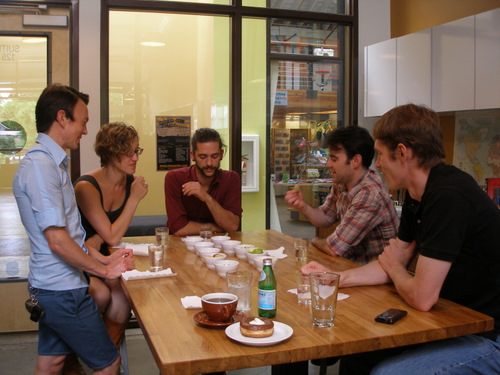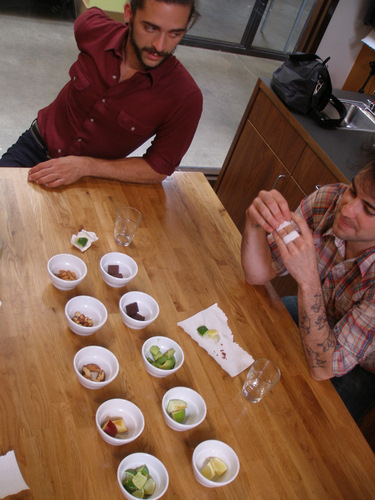Last weekend, after stopping by Overland Park to listen to Leaves Russell perform at the Organic Brewers Festival, I made my way over to Ristretto Roasters café on North Williams Ave., to have some coffee with Jinsu Lee, a South Korean coffee aficionado who has also explored many different cafés around Portland (he provided the photos for this post). We like to get together once in a while to talk about coffee and what the future of the coffee industry might be, especially in South Korea, where specialty coffee is just beginning to take off.
When I got to the café, Jinsu was already sitting at a back table with a group of people. He waved me over and introduced me to the group—Ryan, Rachel, Hank and Steve (all Ristretto employees) and told me that they had invited us to join them. Unknowingly, we had stumbled upon Ristretto’s weekly Sunday public coffee event.
Each Sunday afternoon at 2:30, Ristretto hosts some kind of event to help educate customers about coffee. Often these are coffee cuppings, but last Sunday’s was a little different. Instead of tasting different coffees, the plan was to taste several different foods as a way to develop and map out our palates. Steve, who is a trainer for Ristretto, led us through the exercise.

Developing a discerning palate is very important for people who work in the coffee industry (especially for coffee buyers and roasters), who need to be sure that they are producing a consistent, high-quality product. It is a skill that takes time to develop. I once heard a café owner tell a group that he and his business partner cupped coffee every single morning for three years. As you can imagine, he felt pretty confident in his ability to detect all of the subtleties and imperfections that are present in a cup of coffee.
If you have read many of my café posts, you know that I try to describe the flavors in each of the coffees. I have mentioned several times that a coffee has hints of berries in it, or some kind of citrus, chocolate or cherries. Two of the more interesting coffees I tried to describe came from Ristretto’s cafés (you can read them here and here). On coffee packages and in conversations with baristas, flavors like dates, honey, leather, tamarind, bergamot, carrots, plums and peaches have also been used. All of these descriptions are somewhat subjective, since we all taste things differently.
A more experienced coffee taster uses less subjective language and describes coffee in terms like acidity, body, sweetness and balance, breaking the coffee down into the responses they cause in our mouth.

Steve’s goal was to teach us to think about tasting in a more methodical way. As we tasted the foods, our assignment was to concentrate on how they felt and where they affected our mouths, tongues and throats. We tasted 10 different foods: almonds, hazelnuts, Brazil nuts, milk chocolate, dark chocolate, avocados, red delicious apples, Granny Smith apples, lemons and limes.
We started out with the least acidic food, the almonds, and then moved step by step toward the most acidic, the limes. Apparently, if you were to start with the limes, the acidity would overload your palate at the beginning and make it much harder to taste the other foods.
Of the three nuts, the almonds were the driest. They were a little bit sweet, affecting the front end of my tongue as I ground them up between my teeth (Speaking of grinding up the almonds, it was kind of amusing to sit there and watch everyone working the foods around their mouths, their faces reflecting a deep concentration as they tried discern all of the tastes and textures. I’m sure I had a funny look on my face too).
The hazelnuts were distinctly sweeter and had more oils in them than the almonds. The Brazil nuts had a little bit of a sandy (mineral) flavor, and were the oiliest of all, leaving a light coating on the inside of my mouth. Steve told us that the difference between the Brazil nuts and the almonds was analogous to the difference between coffees with a lot of body and those without it.
We discussed body some more as we moved into the chocolates. We started with the milk chocolate, which was very sweet and creamy. It had lots of body. The dark chocolate, in contrast, was only a little bit sweet, and it dried out my mouth as I chewed it. Our guide told us that the drying effect came from the tannins in the cocoa. He said it was like a dry wine, where the wine is fermented with the skins still on the grapes. This leaves more of the tannins in the wine, giving the wine that mouth-drying feel.
After the dark chocolate came the avocado. The avocado was another demonstration of something with a lot of body. The oils in the avocado coated our mouths as we swished the slimy fruit around inside them.
The two apples followed the avocado. This was the beginning of the acidity phase of the tasting. The light acidity of the red delicious apple is similar to (though sweeter than) some of the berry or stone fruit acidity that some coffees have. It stays more towards the front of your tongue. The Granny Smith apples are a bit more tart, so as soon as you chew them up, the acidity moves up the sides of your tongue.
When we got to the lemons, everyone prepared to pucker up. We bit enthusiastically into the chunks of raw lemon and WHAM! Faces around the table tightened up as the lemon juice hit our taste buds. The lime had a similar affect. Its acidity grabbed the middle of my tongue, then as I swallowed, it latched onto the back of my throat and lingered. The lime was so acidic that it kind of burned and almost tasted salty. Jinsu quipped that we could have used some tequila to go with it, a statement that was greeted with a nod of agreement from everyone.
After we finished tasting, we sat around for a while and talked about coffee, because that’s what coffee people do when they get together, especially after going through a tasting exercise like this one. We concluded that Portland is a great city to learn about coffee, because cafés like Ristretto are always trying to educate their customers on the finer points of the beverage.
If you are looking for something to do on a Sunday afternoon, I recommend that you stop by Ristretto and check out what they are sharing that day. You might get to try or taste something you’ve never had before, or you might just get to hang around with a bunch of coffee enthusiasts. Either way, you should have a good afternoon at one of Portland’s best cafés.